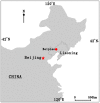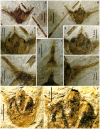The earliest fleshy cone of Ephedra from the early cretaceous Yixian Formation of northeast China
- PMID: 23341964
- PMCID: PMC3544918
- DOI: 10.1371/journal.pone.0053652
The earliest fleshy cone of Ephedra from the early cretaceous Yixian Formation of northeast China
Abstract
Bracts of female cones of extant gymnosperm Ephedra (Joint fir) are either colorful and fleshy (section Ephedra), or dry-winged and membranous (section Alatae), or dry and coriaceous (section Asarca), which have played a crucial role in long-distance seed dispersal that is responsible for a wide distribution of the genus in semiarid and arid areas of Eurasia, North Africa, North America, and South America. Recent molecular systematic studies on Ephedra have suggested that the fleshy bracts in character evolution may be plesiomorphic relative to the dry, membranous and coriaceous bracts. However, little is known about when the fleshy bracts of Ephedra have made their debut in the geological past. Herein, we describe a novel, fleshy bract-bearing female cone macrofossil from the Early Cretaceous (ca. 120-125 Ma) Yixian Formation in Liaoning, northeastern China. This cone bears three ellipsoid seeds subtended by only one whorl of fleshy bracts. Each seed has a thin outer envelope and an inner integument that extends upward and passes through the opening of the outer envelope, forming a thin and straight micropylar tube. Such a syndrome shows the closest similarity to an extant triovulate species Ephedra intermedia in the section Ephedra, but the latter bears a whorl of terminal fertile bracts and more than one whorl of inferior sterile bracts, and a thick outer envelope. Hence, we establish a new fossil species Ephedra carnosa. Our discovery provides the first direct macrofossil evidence for the previous molecular systematics of Ephedra, implying that the origin of fleshy bracts in Ephedra should not have been later than that of the membranous and coriaceous bracts by at least the Early Cretaceous.
Conflict of interest statement
Figures





Similar articles
-
Chengia laxispicata gen. et sp. nov., a new ephedroid plant from the Early Cretaceous Yixian Formation of western Liaoning, Northeast China: evolutionary, taxonomic, and biogeographic implications.BMC Evol Biol. 2013 Mar 27;13:72. doi: 10.1186/1471-2148-13-72. BMC Evol Biol. 2013. PMID: 23530702 Free PMC article.
-
Fossil record of Ephedra in the Lower Cretaceous (Aptian), Argentina.J Plant Res. 2017 Nov;130(6):975-988. doi: 10.1007/s10265-017-0953-1. Epub 2017 May 20. J Plant Res. 2017. PMID: 28528483
-
Heterochrony and repurposing in the evolution of gymnosperm seed dispersal units.Evodevo. 2022 Feb 16;13(1):7. doi: 10.1186/s13227-022-00191-8. Evodevo. 2022. PMID: 35172885 Free PMC article.
-
A new early Cretaceous relative of Gnetales: Siphonospermum simplex gen. et sp. nov. from the Yixian formation of northeast China.BMC Evol Biol. 2010 Jun 17;10:183. doi: 10.1186/1471-2148-10-183. BMC Evol Biol. 2010. PMID: 20565755 Free PMC article.
-
Behaviors and Interactions of Insects in Mid-Mesozoic Ecosystems of Northeastern China.Annu Rev Entomol. 2021 Jan 7;66:337-354. doi: 10.1146/annurev-ento-072720-095043. Epub 2020 Sep 11. Annu Rev Entomol. 2021. PMID: 32916066 Review.
Cited by
-
A Review on Worldwide Ephedra History and Story: From Fossils to Natural Products Mass Spectroscopy Characterization and Biopharmacotherapy Potential.Evid Based Complement Alternat Med. 2020 Apr 30;2020:1540638. doi: 10.1155/2020/1540638. eCollection 2020. Evid Based Complement Alternat Med. 2020. PMID: 32419789 Free PMC article. Review.
-
Shaolinia: A Fossil Link between Conifers and Angiosperms.Plants (Basel). 2024 Aug 5;13(15):2162. doi: 10.3390/plants13152162. Plants (Basel). 2024. PMID: 39124280 Free PMC article.
-
A new macrofossil ephedroid plant with unusual bract morphology from the Lower Cretaceous Jiufotang Formation of northeastern China.BMC Evol Biol. 2020 Feb 4;20(1):19. doi: 10.1186/s12862-019-1569-y. BMC Evol Biol. 2020. PMID: 32019502 Free PMC article.
-
Evolutionary Recycling of Light Signaling Components in Fleshy Fruits: New Insights on the Role of Pigments to Monitor Ripening.Front Plant Sci. 2016 Mar 7;7:263. doi: 10.3389/fpls.2016.00263. eCollection 2016. Front Plant Sci. 2016. PMID: 27014289 Free PMC article. Review.
-
A New Gnetalean Macrofossil from the Mid-Jurassic Daohugou Formation.Plants (Basel). 2023 Apr 24;12(9):1749. doi: 10.3390/plants12091749. Plants (Basel). 2023. PMID: 37176807 Free PMC article.
References
-
- Gifford EM, Foster AS (1989). Comparative morphology of vascular plants, third edition. New York: WH Freeman. 626p.
-
- Stevenson DW (1993) Ephedraceae. In: Flora of North America Editorial Committee, edtors. Flora of North America North of Mexico, vol. 2. New York: Oxford University Press. pp. 428–434.
-
- Price RA (1996) Systematics of Gnetales: a review of morphological and molecular evidence. Int J Plant Sci 157: S40–S49.
-
- Fu LG, Yu YF, Harald R (1999) Ephedraceae. In: Wu ZY, Raven PH, editors. Flora of China, volume 4. Beijing: Science Press & St. Louis: Missouri Botanical Garden. pp. 97–101.
-
- Caveney S, Charlet DA, Freitag H, Maier-Stolte M, Starratt AN (2001) New observations on the secondary chemistry of world Ephedra (Ephedraceae). Am J Bot 88: 1199–1208. - PubMed
Publication types
MeSH terms
LinkOut - more resources
Full Text Sources
Other Literature Sources
Miscellaneous

